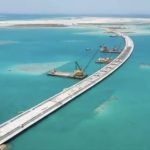Brief
Strong winds, seismic activity and the passage of tall container ships all had to be taken into account during the construction of Turkey’s recently opened 1915Canakkale Bridge, the world’s longest suspension bridge. Rob Hakimian explores the challenges faced by designers and builders and the feats of engineering required to complete the span linking Asia and Europe across the Dardanelles.
Insight
The 1915Çanakkale Bridge officially took the title of the world’s longest suspension bridge when it came into operation on Friday 18 March, but it’s taken five years of work and several construction feats to get there.The £1bn bridge spans the Çanakkale Strait, about 10km south of the Sea of Marmara, and is said to connect Europe and Asia (although it is entirely within Turkey).
It’s an area of noted high winds and high seismic activity, while high-stacked container ships pass through the strait frequently, all of which had to be taken into account. Designer Cowi ensured that the bridge had a 69.3m clearance underneath, and adopted a twin box girder structure to support the deck with a 9m gap in between to ensure aerodynamic stability amidst the high winds.
The bridge’s 2,023m main span is record breaking, but just as striking are the 318m-tall towers that support the cables and the deck, which are the highest towers on a suspension bridge. They were constructed by Australian contractor Marr, which was brought onto the project early and brought innovative ideas that made their assembly far more efficient.
Under the original plans drawn up by DLSY joint venture (DL E&C (formerly Daelim), Limak, SK ecoplant and Yapı Merkezi), the towers were to be constructed in the traditional manner of lifting small pieces individually and welding them in place. Marr showed them it was possible to do it using modular construction and fewer, heavier lifts.
READ MORE






Recent Comments